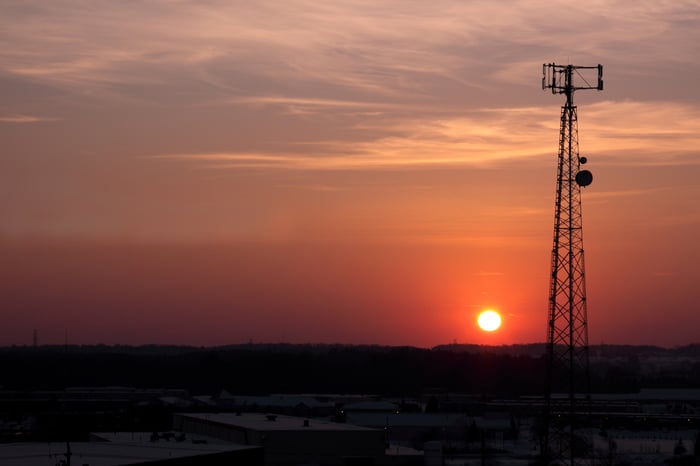Brookfield Infrastructure Partners (BIP 3.35%) has grown tremendously in the decade since its formation. It has gone from a small utilities and timber owner with operations in four countries to a global infrastructure giant with holdings in utilities, energy, transport, water, and communications infrastructure spread across 15 countries. That expansion has grown the company's earnings by a 20% compound annual rate, which in turn has fueled 12% compound annual growth in its distribution to investors, enabling it to deliver a total return of more than 465%, easily outpacing the 125% return of the S&P 500.
While maintaining that pace will be hard to do over the next decade, Brookfield remains excited about the opportunities that lie in front of it. That was evident from the comments of CEO Sam Pollock on the company's third-quarter conference call, where he pointed to three areas that should drive growth over the next decade.

Image source: Getty Images.
Data is the new oil
One area Pollock noted that the company plans to focus on is "the data infrastructure space." He said:
Data is the fastest growing commodity in the world, with global usage growing exponentially, which requires massive investment in networks to store and transmit it, like fibre and telecom, where we have already made investments and remain focused on growing our portfolios.
Over the past decade, most of Brookfield's investments have been in assets that move and store physical commodities like coal, natural gas, and water. However, the company sees the infrastructure that supports data, like cell phone towers, as a significant growth driver going forward given the rapid pace it's growing.
For example, James Taiclet, the CEO of leading global cell tower owner American Tower (AMT 0.17%), recently noted that they "expect that annual mobile data usage in the U.S. will continue to expand by an average of at least 25-30%, and will grow even more rapidly in our international markets over our next five year planning period." That growth led American Tower to believe that the U.S. alone will need to spend $30 billion per year on infrastructure to support this growth, with even more spending required worldwide. Those trends should "drive substantial demand for tower space," according to Taiclet, fueling healthy long-term earnings growth for tower owners, including Brookfield since it owns a tower portfolio in France and plans on making additional investments worldwide.
Building better cities
Another appealing growth market for Brookfield is municipal infrastructure. As Pollock pointed out:
Trillions of dollars have been committed globally to making cities smarter and more connected, efficient and environmentally friendly to accommodate an increasing rate of urbanization. We see the largest opportunities for us in district energy, where we already have operations in 11 North American cities, and energy efficient systems, such as smart meters, where we continue to deploy substantial capital. Additionally, we are ideally suited to capture scale in this sector given Brookfield's vast urban property presence.
With more people around the world moving to cities, it's opening new opportunities to build the infrastructure needed to support tightly packed urban areas. One that Brookfield has focused on is district energy, which is a central heating and/or cooling system that serves a group of buildings. Not only does the company already operate several of them already in North America, but it has a leg up on the competition to increase its scale because its parent company, Brookfield Asset Management (BN 1.06%), holds a vast urban real estate empire. One of the focuses of Brookfield's real estate arm, Brookfield Property Partners (BPY), has been to develop large city centers into "live, work, play" communities, which are ideally suited for district energy.

Image source: Getty Images.
Looking to the east
The third opportunity that Brookfield Infrastructure intends to pursue, according to Pollock, is "making Asia a larger part of our capital allocation." He noted:
Asia is the world's largest and fastest growing market, with current GDP growth of nearly 6%. It is also estimated that by 2030, the middle class in Asia is expected to be over 150% of what it is today at almost 3.5 billion people. With this growth and Brookfield's established presence in Asia, we will look to allocate capital to fund the build-out and maintenance of critical infrastructure across all sectors where we invest.
One spot in Asia where Brookfield has been pouring money into lately is in India. It recently invested $100 million into another portfolio of toll roads in the country, which more than doubled the size of that business. Meanwhile, the company is actively pursuing cell tower acquisitions there. Pollock noted on the call that, aside from American Tower, there were few bidders for these assets, which suggests Brookfield can get a good deal.
No shortage of growth
Pollock's comments on the call suggest that Brookfield Infrastructure Partners has plenty of expansion opportunities to pursue in the coming years. That makes it increasingly likely that the company can continue growing earnings and the distribution above the 5% to 9% annual target it can achieve with organic growth alone. If that's the case, the company should have no problem continuing to deliver market-smashing returns.





